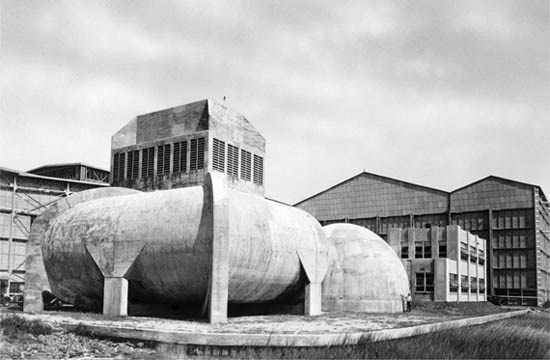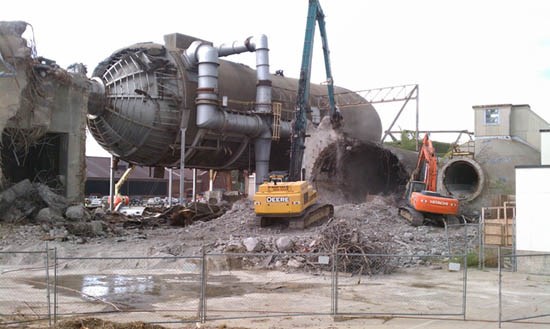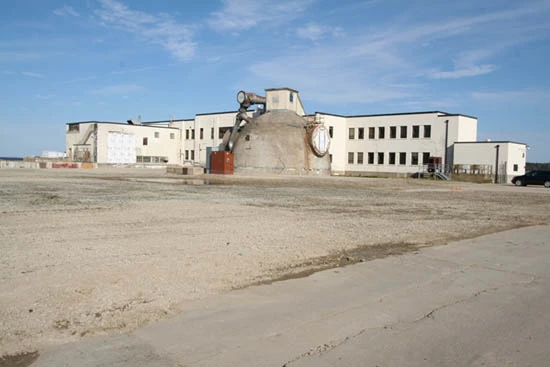
Photo No. L-12470, courtesy of NASA Langley Research Center.
Eight-Foot High Speed Tunnel
Hampton (City), VA
Designated an NHL: October 3, 1985
Designation withdrawn: August 25, 2014
The Eight-Foot High Speed Tunnel, which was completed in 1936, was a landmark in wind tunnel design. At the time of the tunnel's construction, the National Advisory Committee for Aeronautics (NACA, the predecessor to NASA) had only two small (11"- and 24"-high) speed tunnels to test aircraft design in speeds ranging from Mach 0.5 to Mach 0.9. While useful, these small tunnels had two severe limitations: first, the small size of these tunnels meant that only small scale models could be tested; and, second, both tunnels were powered by the rapid blowdown of the Variable Density Tunnel and were thus restricted to tests lasting less than a minute.
The Eight-Foot High Speed Tunnel solved both of these problems. It was large enough to accommodate sizeable test models and even complete aircraft parts on occasion. It was also a continuous flow tunnel that could operate almost indefinitely, therby giving the engineers sufficient time to run their tests and to check their test results. For the first time, NACA engineers had a research tool that could supply high speed test results on a large scale.
Over the years NACA engineers continued to modify and upgrade the Eight-Foot High Speed Tunnel. After World War II, NACA engineers began to work on improving wind tunnel performance in the transonic range (Mach 0.7 to Mach 1.4). It had long been known that airflow within the test section of a transonic wind tunnel did not represent the actual conditions of free flight. The problem was that the natural pattern of airflow in this range is disturbed and altered by the existence of the walls of the tunnel. This problem became severe in the area of Mach 1 and was known as the tunnel choking effect.
In 1946, Ray Wright at Langley analyzed the potential of a partially-open or slotted wind tunnel wall. His results suggested that slots occupying about 6 percent of the wall would closely duplicate free-air conditions. In February 1950, the Eight-Foot High Speed Tunnel was shut down and slotted walls were added to the test section. The concept worked and NACA now had the first wind tunnel in the world that would give accurate test results in the transonic range. Since all supersonic aircraft would have to fly briefly in the transonic range, knowing what happened to aircraft in this transition zone was critical to the supersonic fighters and bombers being planned in the postwar era. The slotted wall concept was immediately put to work testing the next generation of American aircraft.

NASA Langley Research Center Photo
Before the tunnel was phased out of operation in 1956, critical tests led to the discovery of the famous Area Rule which dictated that the fuselage of supersonic aircraft should be constricted where the wings are attached and then expanded at their trailing edges. This eliminated the possibility of generating strong shock waves behind an aircraft that can act as a drag on speed.
Many modern wind tunnels are derived from the technology extended or developed at Langley by NACA engineers. The Eight-Foot High Speed Tunnel was the first continuous flow, high-speed tunnel able to test large models and actual working parts of airplanes. The addition of the slotted throat design was revolutionary for its time and gave accurate wind tunnel data in the transonic range. Many modern wind tunnels incorporate some variation of these features of pressure, large scale, high speed, continuous flow, and slotted throat design. These tunnels marked the emerging technological superiority of the American aircraft industry. After the Second World War, this technology was to provide the base upon which Americans would begin to construct rockets that would eventually fly to the moon and beyond.
The Eight-Foot High Speed Tunnel was deactivated in 1956 and was abandoned. The original test section of the tunnel was used for storage. This tunnel was designated a National Historic Landmark as a result of the National Park Service's 1984 Man in Space Theme Study.
The character-defining tunnel portion of the Eight-Foot High Speed Tunnel was demolished in 2011. The Landmark designation was withdrawn on August 25, 2014, and the property was also removed from the National Register of Historic Places.

NASA Langley Research Center Photo / Mary Gainer
Last updated: August 29, 2018
